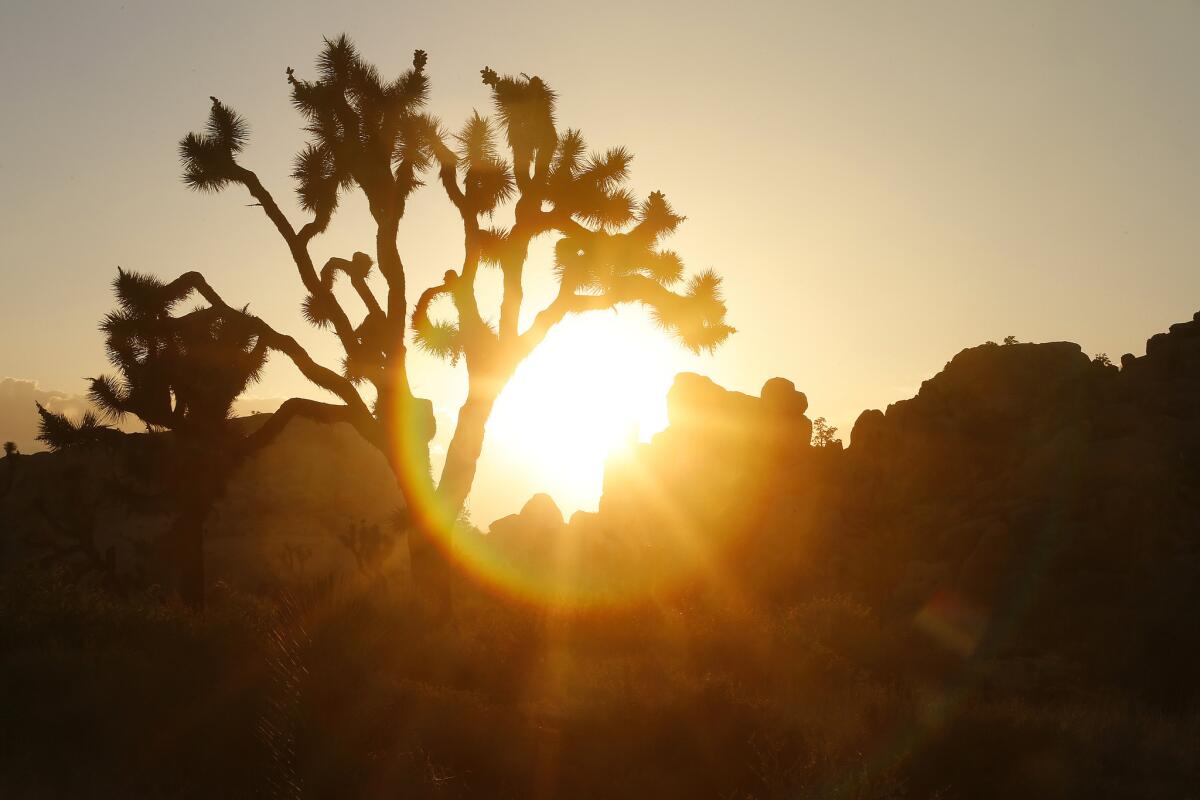These 3 Joshua Tree musical questions just might defeat you

- Share via
You’ve probably heard a thing or two about the dry hills, dramatic boulders and rich musical history of the area around Joshua Tree National Park. But these questions might stump you:
Which guitar-slinging Kentish lad and art school dropout, now age 76, has been photographed shirtless and sprawled in the dirt of or near Joshua Tree National Park?
What distinction can Queens of the Stone Age singer-guitarist Josh Homme claim that other famed musicians with high desert history cannot?
And let’s talk about Allie Wruble. In the 1940s, Wrubel wrote the first pop song about the greater Joshua Tree area, “The Lady From 29 Palms.” The Andrews Sisters sang it. Frank Sinatra too. But Wrubel’s best-known song, also from the 1940s, was a musical collaboration for the Disney film “Song of the South.” What song?
These and other questions will likely be answered at a new class offered through the Desert Institute at Joshua Tree National Park. (Actually, they’ll be answered at the end of this story too.)
The daylong course and caravan car tour will survey the area’s musical history since the 1940s, including the death of singer-songwriter Gram Parsons, the presence of Scottish folk-pop singer Donovan in the 1970s and ’80s, and the influence of spiritualists on desert musicians.
The teacher is Bruce Fessier, who retired in 2019 after 40 years of writing about music and the arts for the Coachella Valley’s Desert Sun. The program, titled “History and Legends of the Joshua Tree Music Scene,” will be offered 10 a.m.-5 p.m. Feb. 29. Cost is $160. Class will begin at the Black Rock Nature Center, 9800 Black Rock Canyon Road, Yucca Valley. More information is available through the Desert Institute and its spring 2020 catalog of field classes.
“I’ve been telling these stories a long time,” Fessier said, adding that the class will probably have room for 12-15 students.
Sights on the tour will include the Joshua Tree Inn, where Donovan (who now lives in Europe) has often stayed. It’s also where Parsons died of a drug overdose in 1973 (Room 8). The tour also includes the Joshua Tree Lake Campground, site of the Joshua Tree Music Festival (set for May 14-17 and Oct. 8-11 this year); and a studio where many high desert musicians have made recordings.
“There are about 30 recording studios in Joshua Tree right now. A lot of musicians come up,” Fessier said. Yet apart from Pappy & Harriet’s, about 12 miles west of Joshua Tree in Pioneertown, “there are very few places to play.”
Eric Burdon’s name (he of the Animals) will come up in the class. So will those of Daniel Lanois (musician/producer), Dick Dale (surf guitar music), Jim Morrison (Doors frontman), Robby Krieger (guitarist for the Doors) and probably Robert Plant (singer, formerly of Led Zeppelin). But U2 not so much.
Although the band released a 1987 album called “The Joshua Tree,” Fessier said, it was recorded elsewhere and the desert photos were taken near the entrance to Death Valley.
“We’ve had cultural history classes for quite a while, but they’re [usually] about either mining in the area or the Native American culture in the area,” said Kevin Wong, program coordinator for the Desert Institute. “This is a stretch, in that it’s vintage, rather than ancient.”
Fessier’s answers to the questions above:
1. Keith Richards. 2. Homme was born in Joshua Tree. 3. “Zip-a-dee-doo-dah,” later sung by Doris Day and many others.
More to Read
Sign up for The Wild
We’ll help you find the best places to hike, bike and run, as well as the perfect silent spots for meditation and yoga.
You may occasionally receive promotional content from the Los Angeles Times.







